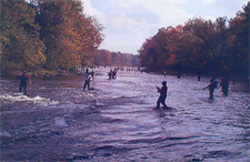Wednesday, January 23, 2008
|
...and the Sky "Ain't" Falling!
Back in November, in my first Off Season Report, I mentioned that there was a very high probability that there would be a 2007 fall egg take shortage of Chinook It is now official that the 2007 egg taking effort did not achieve normal harvest goals, and as a result a decrease in Chinook stocking will occur this spring. What does this mean? |

|
Is our Lake Ontario World Class Fishery about to lose its lofty status? Is there a doom and gloom future looming on the Lake Ontario horizon? Not really, and in all probability the egg take shortfall will be but a small bump in the road and will have little impact on charter and recreational future fishing opportunities on mighty Lake Ontario.. Allow me to explain.
The Lake Ontario fishery is based on a stocking approach to fishery management. Over the past 30 years, the New York State Fishery Section has successfully developed a fish culture system to collect salmon and trout eggs and propagate gazillions of salmon and trout for stocking in the lake. Has this ongoing effort been a success? Of course it has! Have there been glitches along the way? Of course there have! Stocking number goals have been purposely manipulated in an effort to reach a fish population level compatible with the lakes ability to provide proper amounts of fish growth energy in the form of prey fish. Its the old predator vs. prey mentality. Through the years, with all the curve balls tossed by mother nature and her offspring known as homo sapiens, the Lake Ontario fishery has remained a truly world class fishing destination. In basic terms, the fishery aspect of the lakes ecosystem has been well managed, not by chance, but rather by scientific design and many times under the mantra that more is not always better.
Every year salmon return to the tributaries to spawn. The Salmon River is the most crucial spawning stream in the system because the only major Chinook salmon rearing hatchery is located there. It is a fact that water flow and water temperature have a profound influence on the spawning run. The optimum water temperature for successful spawning is 50 degrees, and water temperatures over 60 degrees present a stressful situation. In the fall of 2007 we had a totally off the chart condition that included extremely low water (100cfs) and abnormally high water temperatures.(over 60 degrees) The drought stricken Salmon River Reservoir was 12 ft. below normal. River flows were unbelievably low, and for the first time ever, egg taking could no longer be delayed in anticipation of cooler water and had to be completed while water temperature was in the 60 degree range. This had never happened before, and because of the time line between egg incubation and spring smolt release the process could be delayed no longer. We have learned from past experience that eggs harvested from 50 degree water will yield about an 80% return from egg to eye up fertile eggs. Eggs gathered from 60 degree water yield a lower survival to eye up stage of about 65%. So while fewer fish returned to the hatchery their eggs produced fewer fertile eggs than normal. To this bubbling brew, mix in the armada of anglers that descended onto the Salmon River this past fall in the lower river expanse, fishing in shallow water and then hooking up to thousands of migrating salmon. This totally legal and usually desirerable angling annual effort only compounded the hatchery egg take woes. Every year the returning salmon must navigate the flowing gauntlet from the river mouth some thirteen miles upstream to the hatchery. It is a strenuous journey made more difficult by the legions of well equipped and efficient anglers. The 2007 low water scenario made that gauntlet an even more challenging journey for the mighty king salmon. The fall of 2007 kept serving up one hurdle after another.
This is the first time in 30 years that salmon egg harvest goals were not achieved and we will hopefully not experience an occurrence like this for some time. However, the DEC has gone to school and is planning and reviewing just what course of action to take should abnormally low water flow conditions once again present a problem. They are looking at options such as newer removable fish catching weirs in other nearby streams where they could easily augment the egg harvest, with quick transfer of eggs from tributary water to the controlled confines of our state of the art hatchery located in Oswego County. They may also elect to institute emergency fishing regulations to briefly ease fishing pressure so as to maximize egg harvest. As this is written contingency plans are being formulated. Once again, we have encountered another bump in the road and the have started the correction process should we receive another visit from the low water, high temperature boogie man.
Consider that in 1995 we stocked only 1.1 million Chinooks into Lake Ontario and the result was that this stocking produced one of the largest salmon runs in history. Even larger than in previous years which saw stockings of 3 million fish. Remember the, "more is not always better scenario?" This fact plus the impact of possible additional salmon spawned naturally in the Salmon River, will certainly contribute to the lakes ability to provide the excellent fishing experiences that we have come to accept as normal.
Its good to be a Lake Ontario sport fishing troller.
Posted By: Capn Gerry Bresadola @ 10:35:25 AM


Search by Keyword
Comment
Posted By: epkakolja@gmail.com
http://4092386.xyz/kenzaih_smvs_kk-d-spazio/tbsb30417.glass_s_kh
contact us http://4091762.xyz/zeroen_fs-kuwabara-curtain/rs004-21.return
Posted on: 7/15/2016 7:13:51 AM




